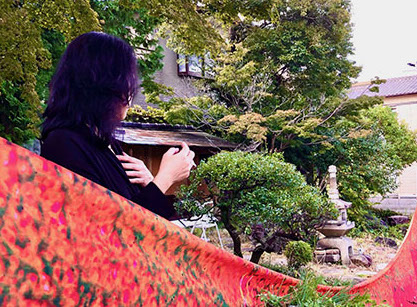“I want to act as a medium for mother nature.”
Paul Zimmerman in conversation with Sarah Fujiwara
Paul Zimmerman: Congratulations on your current exhibition in New York. It is called ‘Melting Petals’. Why did you choose this title?
Sarah Fujiwara: Thank you. I use photographs in all of my work. I think that the medium of photography makes us aware of various boundaries; between the photographer and the subject; the present, past, and future; that which is real, and that which is unreal. For this exhibition, I focused on the dividing line between data, in the form of digital photographs, and people’s memories, and creating harmony between the two. The medium I used for this was the poppy flower. Each petal is made to symbolize harmony. The title embodies the natural process of both memories and petals gradually melting and transforming over time.
PZ: How do you create your work?
SF: I first took a digital photo of the poppy flower, then checked the photo around three months later. The image of the real thing stored on the computer is different from the memory of the impression (image) left by my five senses. Some parts have major differences while some are quite similar. I choose the ones that have the biggest contrasts and created the pieces using a variety of manual techniques and technology to reproduce the image from my memory to the best of my ability.
PZ: How do you find the balance between technology and artistic expression?
SF: Technology is one of the methods I use to turn the things I want to express into reality, and traditional tools are also part of my toolbox. By understanding the different characteristics of each tool and figuring out which ones are the most effective at expressing different ideas, I’m able to strike a balance between them.

PZ: How do you select you medium?
SF: I look for a medium that’s suited to the idea of the piece I have in my head. I also get information from professionals who work with a range of different mediums regularly. My new piece, Melting Petals 50, is a 10m long piece made from organdy fabric. In 2014, I unveiled an installation in France which was a small space created with organdy printed with photos of roses. Drawing from that experience, I discussed with experts to create a softer, more vibrant appearance, using the latest printing technology and fabric.
PZ: Nature seems to be an inspiration for you. Why is it important?
SF: I grew up in an area surrounded by a large river where we often experienced floods. Ever since I was a child, I realized how powerless humanity is against mother nature and was afraid. But at the same time, I was moved by her raw beauty and power. I want to act as a medium for mother nature, creating artworks containing the breath of nature and delivering its message to people by exhibiting them in cities especially, where nature is scarce, so that many people can see my works and feel the way I do about nature.
PZ: How did you become interested in art?
SF: My grandfather was a collector of Japanese paintings and tea ceremony artifacts from the Edo period (16th – 18th centuries), and some of my relatives were Buddha statue sculptors and Japanese-style painters, so I grew up surrounded by art. I grew up in an environment where art was an ordinary part of everyday life.
PZ:. How would you describe your style?
SF: Art that transcends Photography.
PZ: Which artists are you most influenced by?
SF: Kanō Tan’yū, a painter of the Kanō school from the early Edo period. I am heavily influenced by the way he used Yohaku (blank space) and how his subjects appear to be floating.
PZ: What are you working on now?
SF: I’ve started working on a new video series and a photo art book of my Melting Petals series.The works are meant to be experienced not just through sight but also by feeling the texture of the paper, smelling the fragrance of the prints, and hearing the sound of the pages flipping; using all five senses and the whole body. Because of the coronavirus pandemic, it’s difficult to head out to a gallery or museum right now to enjoy the art in person, but I really want to allow people to hold it in their hands instead of just viewing online.
PZ: Does this pandemic impact your work and sensibility?
SF: Yes. My art has become more abstract. Also, rather than just photographing nature and sealing it within my pieces, my desire to take those pieces and then release them back
into nature as an art installation has grown stronger. Right now, I yearn to coexist with nature through my art.
